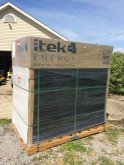Well folks, I thought I'd pass along some information.
Last summer I purchased 12kW of used Trina 250W panels. The price, even with shipping, was $.28 cents a watt. These were 60 cell, mono crystal in a black frame.
Life is good! Right?
I completely re-did my 48V system using these panels. I was, and still am, extremely happy with the results!
However! When I went to install these in my soon to be done grid tie, the electrical inspector rejected them even without seeing the panels. WHY? Because the company I purchase them from removed the labels that showed the panels was UL approved. I knew this ahead of time and didn't give it much thought. However, Without the label, he would't okay my system. So I had to purchase some new panels to get the approval.
Once I did that, and the system was passed, I installed some of the used panels.
That's when I had troubles. The solaredge inverter would fault with a 'isolation error' and only when I disconnected the used panels did the inverter start up.
long story... all the used Trina modules have leakage from the wires to the frame, and thus are unusable in my gird tie system.
Solaredge trouble shooting wants you to use a megger to read the resistance between the positive and negative leads connected TOGETHER and to the frame. A good panel should have at least 80MΩ of resistance. The new panels read >4000Ω.
The trina panels? 100kΩ 1000kΩ and 438KΩ.... all panels failed this test. Now if you wait a few dry sunny days, the panels dry out and the inverter will operate.
Today, right now my solaredge inverter is telling me the isolation value is 472kΩ. The minimum is 600kΩ. Normal is 11,000KΩ
On the battery array, if you disconnect the positive lead and connect it to your meter, then place the negative lead to the frame, I can measure 28V!
My fluke 83 meter has such a high input impedance that it can read that voltage. There isn't enough current flow to trip the GFI inside the Midnite Classic charge controller.
So? Bottom line. Sometimes the sweetness of a good deal will leave a bitter taste in your mouth.
I'm mike
Last summer I purchased 12kW of used Trina 250W panels. The price, even with shipping, was $.28 cents a watt. These were 60 cell, mono crystal in a black frame.
Life is good! Right?
I completely re-did my 48V system using these panels. I was, and still am, extremely happy with the results!
However! When I went to install these in my soon to be done grid tie, the electrical inspector rejected them even without seeing the panels. WHY? Because the company I purchase them from removed the labels that showed the panels was UL approved. I knew this ahead of time and didn't give it much thought. However, Without the label, he would't okay my system. So I had to purchase some new panels to get the approval.
Once I did that, and the system was passed, I installed some of the used panels.
That's when I had troubles. The solaredge inverter would fault with a 'isolation error' and only when I disconnected the used panels did the inverter start up.
long story... all the used Trina modules have leakage from the wires to the frame, and thus are unusable in my gird tie system.
Solaredge trouble shooting wants you to use a megger to read the resistance between the positive and negative leads connected TOGETHER and to the frame. A good panel should have at least 80MΩ of resistance. The new panels read >4000Ω.
The trina panels? 100kΩ 1000kΩ and 438KΩ.... all panels failed this test. Now if you wait a few dry sunny days, the panels dry out and the inverter will operate.
Today, right now my solaredge inverter is telling me the isolation value is 472kΩ. The minimum is 600kΩ. Normal is 11,000KΩ
On the battery array, if you disconnect the positive lead and connect it to your meter, then place the negative lead to the frame, I can measure 28V!
My fluke 83 meter has such a high input impedance that it can read that voltage. There isn't enough current flow to trip the GFI inside the Midnite Classic charge controller.
So? Bottom line. Sometimes the sweetness of a good deal will leave a bitter taste in your mouth.
I'm mike



